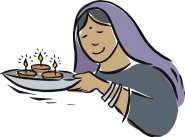
Worksheets and No Prep Teaching Resources
Reading Comprehension Worksheets
Ancient India

Ancient India
 Worksheets and No Prep Teaching Resources Reading Comprehension Worksheets Ancient India |
 Ancient India |
| edHelper's suggested reading level: | grades 5 to 7 | |
| Flesch-Kincaid grade level: | 6.38 |
|
Diwali and the Epic Tale of Rama
By Vickie Chao |

|
 1 Everybody has his or her own favorite holiday. If we put this issue to a vote in India, Diwali can probably win the title by a landslide. Diwali is a Hindu holiday that takes place once a year around October and November. During the five-day celebration, people wear new clothes. They exchange sweets. They set off firecrackers. And most importantly, they light up oil lamps ("diyas" in Hindi) and place them all around their homes. The reason for doing this is obvious, for Diwali is the Festival of Lights!
1 Everybody has his or her own favorite holiday. If we put this issue to a vote in India, Diwali can probably win the title by a landslide. Diwali is a Hindu holiday that takes place once a year around October and November. During the five-day celebration, people wear new clothes. They exchange sweets. They set off firecrackers. And most importantly, they light up oil lamps ("diyas" in Hindi) and place them all around their homes. The reason for doing this is obvious, for Diwali is the Festival of Lights! |
Create Weekly Reading Books
Prepare for an entire week at once! |
| Leave your feedback on Diwali and the Epic Tale of Rama (use this link if you found an error in the story) |
 |
Ancient India
|
 |
Social Studies
|